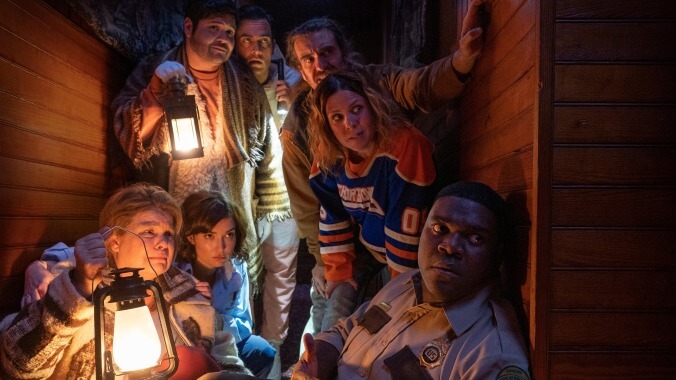Werewolves Within puts a goofy, lycanthropic spin on the whodunit
It’s the latest spirited attempt to do Clue with werewolves


“I feel like I’m in one of those dinner-theater murder things,” lampshades a character in Werewolves Within. It’s about as wink-wink self-aware as anyone gets in this rowdy horror-comedy, which does indeed take the general shape of a night of live-action Clue, except with the wrinkle that the killer uses tooth and claw instead of candlestick or dagger to periodically shorten the list of potential suspects. None of these eccentrics, gathered in the accusing parlor of a small-town inn, have the encyclopedic video-clerk recall of Randy from Scream, still probably the gold standard of horror whodunits. If they did, they might note that “Agatha Christie with werewolves” is a premise previously botched by both Amicus and the Howling franchise. Josh Ruben, the director here, likely knows that. After all, his last film name-dropped Silver Bullet, yet another entry in the robust subgenre of mysteries with furry, fanged culprits. It’s to his credit that it’s at least a little tougher to pinpoint the guilty party this time—to play Sherlock and root out the hound hiding in his Baskerville Manor.
General though its influences may seem, Werewolves Within draws its scenario of distrust and accusation from a specific source. It’s an adaptation of the Ubisoft title of the same name, which technically lands it towards the top of any power ranking of movies based on video games. Technically because the video game is really just a glorified VR version of the popular card game Werewolf. And even that is just a riff on the old party staple Mafia, in which players adopt different predetermined roles and try to sniff out who among them is a wolf (or goombah) in sheep’s clothing. “Social deduction” is the fancy way to describe a genre of game that really comes down to who’s the best liar.
That couldn’t be Finn, the genial and unfailingly polite park ranger relocated to the cozy wooded town of Beaverfield at the start of Werewolves Within. Or could it? As played, in a rare starring role, by Detroiters and Veep star Sam Richardson, Finn is a textbook pushover; he’s first seen forcing out a faux-manly bellow en route to his new post, following along to an audio book designed to get teddy bears in touch with their inner grizzlies. Of course, Finn’s meekness could be the perfect cover for a man with a monstrous secret. But his status as audience surrogate and makeshift detective does shift the crosshairs of suspicion away from this amusingly accommodating outsider.
Still, Finn’s arrival does coincide with both a full moon and the apparent appearance of a beast on the prowl. He’s in town less than 24 hours before someone or some thing slashes the generators and makes bloody work of a pint-sized canine companion. Before corralling every possible wolf- man or woman under one roof, Werewolves Within establishes a source of larger tension tearing the town apart: the attempts by an oil baron (Wayne Duvall) to buy up all property in the area and make room for a new pipeline. Even without this fresh conflict, however, Beaverfield is a hotbed of quirks and pet peeves. “Everyone here is a little questionable,” insists new mail carrier Cecily (Milana Vayntrub), and the film’s cast labors hard to underscore her point.
Ruben’s first feature, Scare Me, was a clever deconstruction. The film’s hook was that the small cast, which included the writer-director himself, acted out campfire tales with the aid of evocative sound effects but without cutaways to the stories the characters were making up. Werewolves Within is a noticeably larger production, with a bigger cast and an actual effects budget. But though Ruben wasn’t behind the keyboard this time (the script was written by Mishna Wolff, fulfilling the destiny of her surname), his sensibilities shine lunar bright through the way the film privileges collisions of personality in contained spaces over creature-feature thrills. His gender politics have made the leap, too—while Scare Me savaged male insecurity, a late twist here shrewdly clowns on a particular fantasy archetype the movie only appears to indulge.
One might just wish that Werewolves Within had sharper characters. An ensemble of comic ringers (among them Michaela Watkins, Catherine Curtin, and newly minted monster-hunting pro Harvey Guillén) can’t quite elevate these bickering neighbors past the stereotypes they embody, all located on the continuum from red- to blue-state values. (Those who thought Knives Out hit the culture-war buttons a little too heavily will likely sigh, too, at the volleys of snowflake and gun-nut insults here.) Werewolf and games of its ilk are fun because they hinge on emotional detective work: They’re about trying to read friends and friends of friends, to parse out the truth from social tells and cracks in the illusion of sincerity. That appeal gets lost when the audience isn’t supplied anything resembling nuanced characters. Werewolves Within seems to recognize its limitations in this department, too quickly abandoning the fruitful The Thing claustrophobia of paranoid group gumshoeing in favor of a third act that piles bodies (and wacky, over-the-top violence) like firewood.
At least Ruben maintains his comic instincts and crack timing throughout. The film possesses a strong touch of Edgar Wright in how it manages both the humor and horror of its conceit: Characters are ricocheted into the frame like silver bullets, while establishing sequences flip through ominous images at a speed that weds suspense to a farcical madcap quality. The movie opens with a quote that fades disquietingly onto the screen, one sentence at a time, before revealing the source of the sentiments as… Mr. Rogers. It’s a great gag that perfectly sets the tone and the philosophy of the mayhem to follow—qualities that make Werewolves Within worth tracking down, even if Ruben can’t quite break the curse of his subgenre, that ongoing failure to find magic in the intersecting hunting parties of Hercule Poirot and Lawrence Talbot.